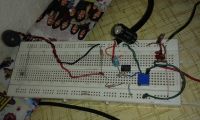djdaga
Newbie level 5

Greetings.
I made this little preamplifier for electret microphone, but I have a problem. Sometimes background noise is quite annoying, as well as high frequency noise (aka the sssssssssssssss). I've worked with some filters and software level and I don't get acceptable results. The microphone picks up on conversations from neighbours, and all the noise mixes with the voice.
I need some advice on how to improve this circuit. I have 12V regulated. If you see the cable is well done and also good quality. Operational *RC4558*/JRC4558/LM4558... I don't have any others on hand.
Here a demo: https://www.youtube.com/watch?v=mSlaXgVjXWY


I made this little preamplifier for electret microphone, but I have a problem. Sometimes background noise is quite annoying, as well as high frequency noise (aka the sssssssssssssss). I've worked with some filters and software level and I don't get acceptable results. The microphone picks up on conversations from neighbours, and all the noise mixes with the voice.
I need some advice on how to improve this circuit. I have 12V regulated. If you see the cable is well done and also good quality. Operational *RC4558*/JRC4558/LM4558... I don't have any others on hand.
Here a demo: https://www.youtube.com/watch?v=mSlaXgVjXWY




